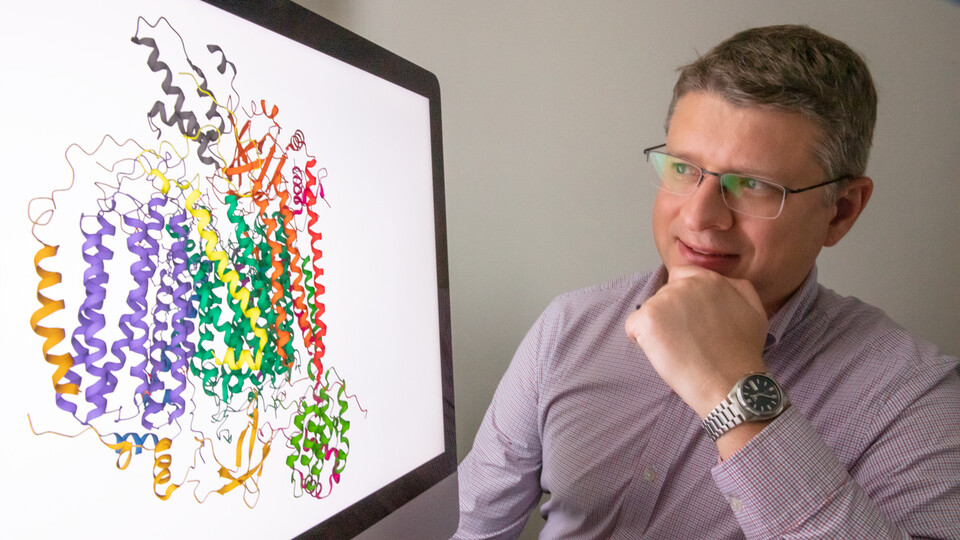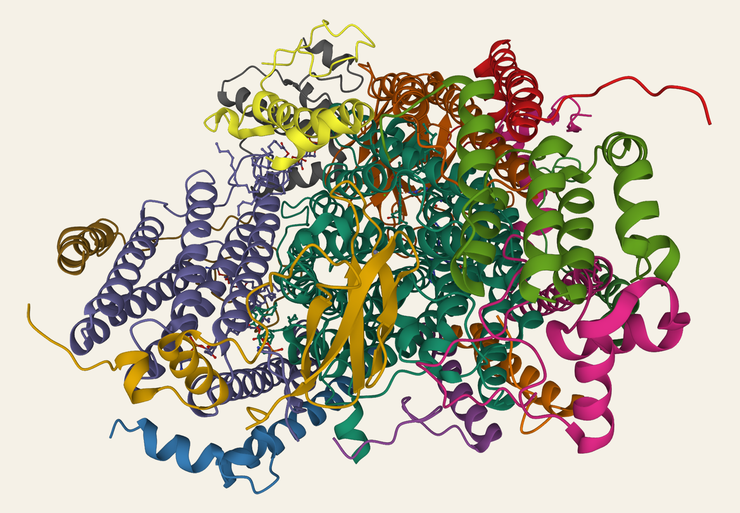· 6 min read
Team reveals surprising details of crucial energy-producing enzyme

A new study from the University of Miami and University of Nebraska–Lincoln has upended decades of doctrine about an enzyme whose mutation or malfunction can trigger fatal diseases early in life.
That enzyme, cytochrome c oxidase, resides in mitochondria, acting as a gateway into the cellular organelles best known for generating energy that powers all sorts of life-sustaining operations. Cytochrome c oxidase is also among the final actors in a Rube Goldberg-esque parade of interactions that transport and ultimately convert biochemical currency — oxygen and glucose — into the energy-storing molecule known as ATP.
The assembly of cytochrome c oxidase itself is hardly a simple process, either. In fact, biochemists have spent years piecing together how the enormous enzyme gets pieced together.
“It’s really sophisticated machinery,” said Oleh Khalimonchuk, Susan J. Rosowski Professor of biochemistry at Nebraska and a leading co-author of the study.
Biochemists initially investigated the enzyme in bacteria, yeast and other single-celled organisms that evolved cytochrome c oxidase long before humans did. But the complexity of both human cells and the enzyme, which consists of more than a dozen subunits, has complicated attempts to assess its assembly in those cells. To date, though, researchers have presumed that the assembly of the enzyme’s catalytic core plays out in humans much as it does in microorganisms.
Led by Miami’s Antoni Barrientos and Eva Nývltová, the Hurricane-Husker team undertook the grueling task of deleting, one by one, more than a dozen genes that direct the production of proteins and other molecules believed to assemble the enzyme in humans. By analyzing the results of each deletion in turn, the researchers managed to identify the molecular MVPs on the assembly line, characterize their contributions to that assembly, and determine their order of operations with near-unprecedented precision.
Some of what they found ran counter to the long-accepted literature of the field.
“The way the concepts have been laid out in bacteria and yeast studies turn out to be not exactly the same in human cells,” Khalimonchuk said of the enzyme-assembling components. “I think this basically shatters a decades-old paradigm in terms of how these factors are behaving.”
One of the principal surprises came in the form of COX11, an assembly-assisting protein so critical in yeast that without it, Khalimonchuk said, “those mitochondria are dead in the water.” In human cells, the team confirmed, COX11 partners with other proteins to chaperone copper atoms across a cell and nestle them in two core subunits of cytochrome c oxidase. From there, the copper atoms help trigger production of energy-storing ATP by accepting electrons and passing protons into a mitochondrion.
Yet when the researchers knocked out the gene responsible for COX11, they discovered that the resulting cells still succeeded in assembling about 15% as many cytochrome c oxidases as they typically do, maintaining roughly 60% of their usual ATP production. The team later determined that human cells missing COX11 can call up other proteins that, despite the lower batting average, can effectively pinch-hit for it. And when the team manipulated cells to churn out more of the pinch-hitting protein known as PET191, the COX11-less assembly of cytochrome c oxidases jumped from 15% to 40%.
“It resolved a conundrum, because a lot of mutations in the assembly factors of cytochrome oxidase are linked to diseases in humans,” Khalimonchuk said. “There are tons of inborn diseases, but never had they been reported with a mutation in COX11 — unlike in any other factor that we’ve been dealing with. This was so bizarre. But now these data actually explain why: because it’s partially dispensable.”
But Khalimonchuk and his colleagues also concluded that COX11, which joins up with certain proteins until those proteins are ready to chaperone copper to the enzyme’s core subunits, acts as a regulatory safeguard against the long-term buildup of toxic molecules. That’s particularly important, he said, given the explosive cocktail of oxygen and electron-rich molecules often swirling around mitochondria.
“You can think about oxidase as a time bomb, because you have all these things that are poised for immediate reaction — accepting electrons, reacting with oxygen and so on,” Khalimonchuk said. “So everything has to be fine-tuned and coming into place (at the right time). If something’s not right — if you have some improper assembly, some orphan subunits, something exposed to an environment that it shouldn’t be — that is a really dangerous situation. They will fire up right away, and that has some pretty detrimental consequences for a cell.
“Part of the reason these diseases are believed to be so nasty and drastic is because of these features of cytochrome oxidase.”
In that way, scrutinizing the minutiae of cytochrome c oxidase will prove essential for better diagnosing and eventually treating the nefarious diseases that its dysfunction can cause, Khalimonchuk said. One rare but devastating example, Leigh syndrome, afflicts the nervous system of newborns, who generally survive no more than a few years.
“There’s a whole spectrum of inborn diseases,” Khalimonchuk said. “They’re all early-onset, because you need to respire (and produce ATP) pretty much from the get-go. Mitochondrial diseases are nasty in general, but these are particularly nasty.”
In explaining the value of mitochondria-focused findings, Khalimonchuk cited recent research showing that administering oxygen to patients with severe mitochondrial diseases — a common tactic in emergency rooms — is actually detrimental.
That alone represents progress, Khalimonchuk said. But moving from correctives and recommendations to potentially life-saving medications will demand that biochemists continue combing fine print from the instruction manuals of cytochrome c oxidase and mitochondrial machinery like it. That means collaboration, he said, and a willingness to take on the “long slog” of the arduous but crucial work.
“We hope that there will be more follow-ups, not just necessarily by us, to even better understand this whole process,” Khalimonchuk said, “and maybe find some other missing pieces.”
The team, which included Nebraska’s Jonathan Dietz and Javier Seravalli, reported its findings in the journal Nature Communications. The researchers received support from the National Institutes of Health, the Muscular Dystrophy Association and the American Heart Association.








